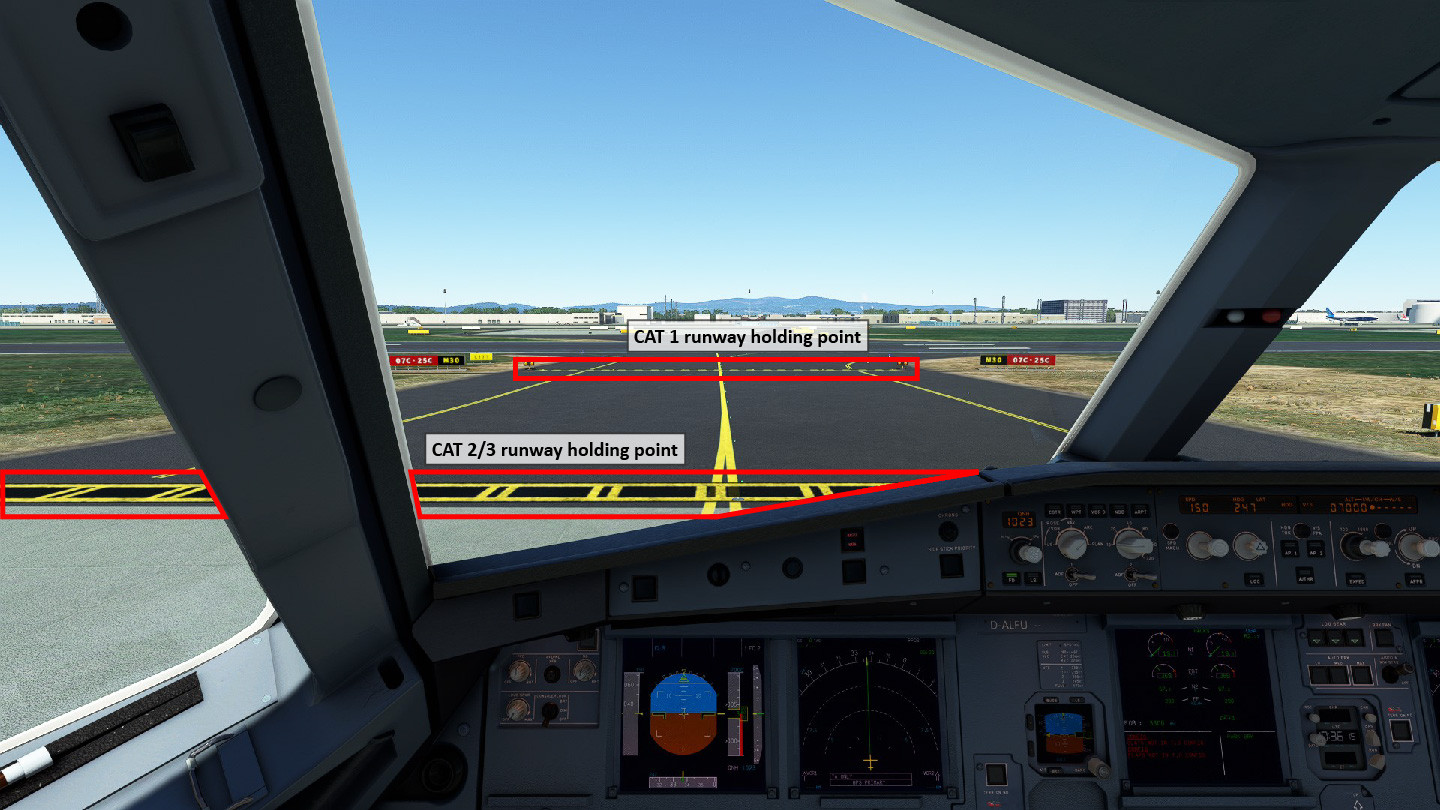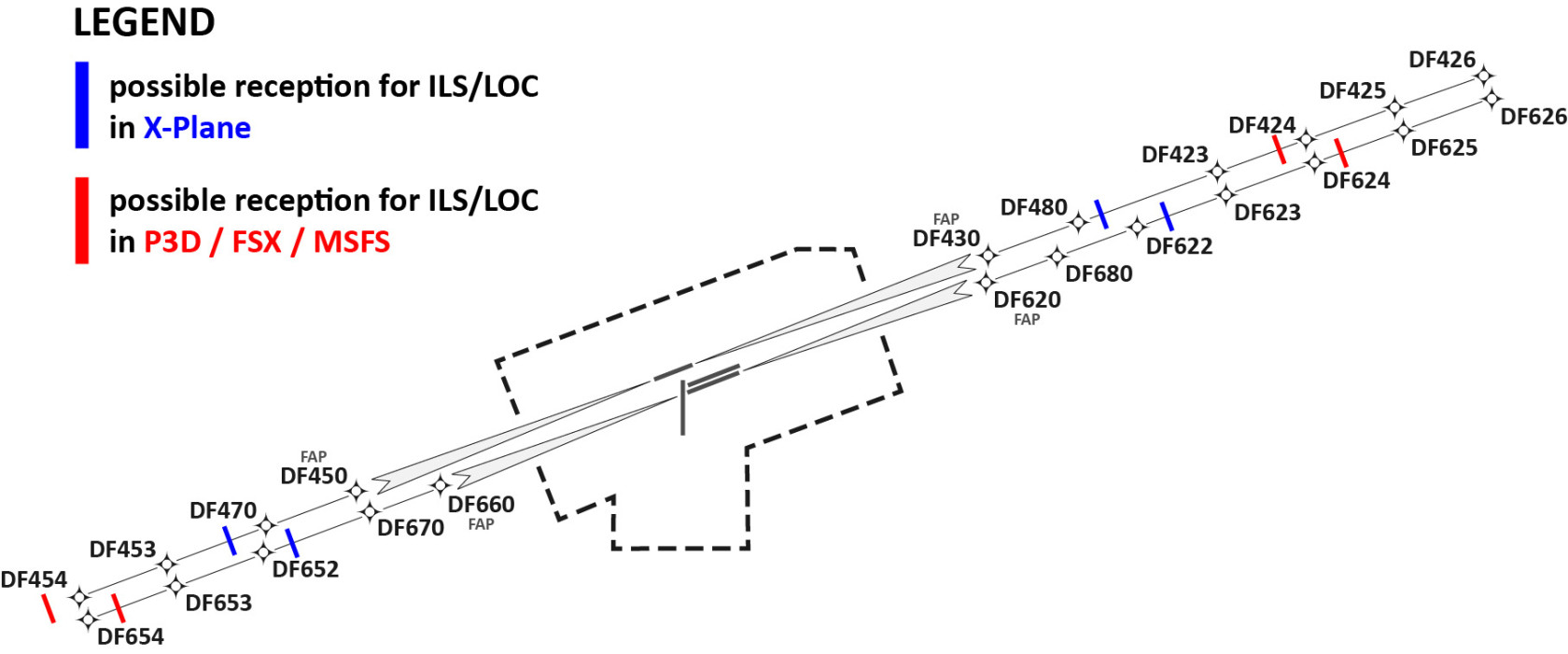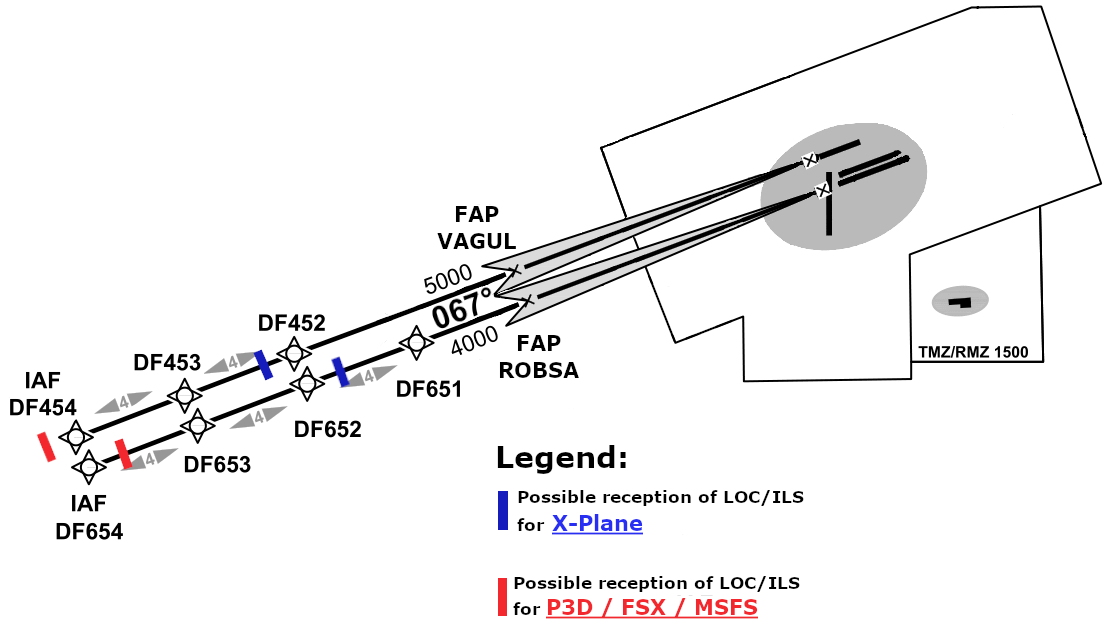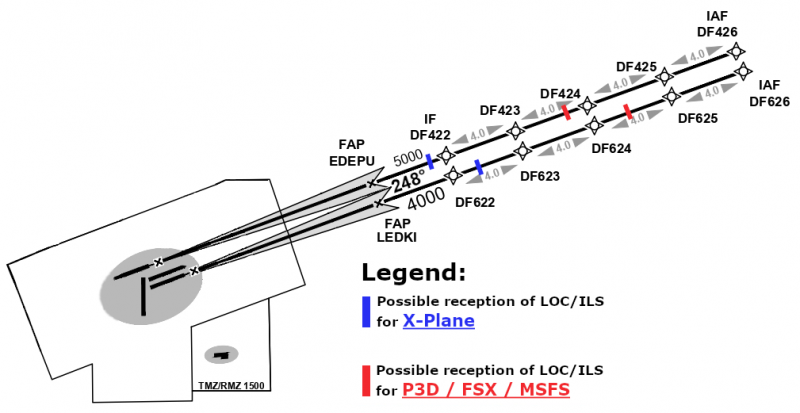Arriving Traffic
We ask all pilots to also read the General section with information relevant to all pilots.
DescendArrival
STAR assignment
YourSTARs landing runway will beare assigned by Arrival or Director (Langen Radar). Any runway can be used from any arrival. Especially during high traffic situations inbounds from the north may expect runway 25R/07L and inbounds from the south runway 25L/07R.
Arrival Route: Inbounds shall expect STARs according to the table below. ATC may deviate from this due to operational reasons. Via FAWUR and EMPAX arrivals expect descent to FL110/FL100 via the STAR. This means you have to descent regarding all altitude restrictionsbased on the waypoint at which you exit your route and the operating direction of the airport. The following table shows the standard STAR assignment; however, controllers might assign a different STAR (seee.g. chartsduring fornight details)operations). Most aircraft are able to provide you with VNAV guidance which should be used unless otherwise needed.
Aircraft typ B747, A380, MD11, A124, L1011 are not allowed at RWY 25R/07L. Expect RWY 25L/07R instead.
Arrival
There is no 250KTS/FL100 restriction at EDDF within airspace C. Normal descent speeds are 280kt ± 20kt until instructed by ATC. On downwind expect vectors to final, mostly shortly after passing abeam the FAF/FAP. Plan your descent accordingly! Maintain good speeds. As a general guidance on base you should be around 220kt, when cleared for the final approach between 200-180kt. Expect to cross the FAF/FAP between 200 -180kt and to maintain 170kt until 5 DME.
When contacting Frankfurt Director report your Callsign only!
ILS-Range: Especially with high amounts of traffic the intercept of the ILS may not be possible within the ILS range of your simulator. It's important that you stay on the extended centerline and don't overshoot the localiser - regardless of receiving a signal or not.
The easiest way to achieve this is by using the waypoints of the transition for the extended centerline:
| 07 |
||
| C |
||
| EMPAX |
B |
C |
| FAWUR |
B |
C |
| UNOKO |
A |
D |
| ROLIS |
A |
D |
| KERAX |
A |
D |
| TANJO |
A |
D |
All STARs into Frankfurt/Main have altitude and speed restrictions. Make sure you comply with these unless they are explicitly cancelled by ATC.
In Germany, you are supposed to file your STAR. If you did so and you have not been cleared for a STAR when reaching the STAR entry fix, follow the filed STAR until reaching the clearance limit.
Descent planning
To avoid having to fly unnecessarily long finals, pilots should plan to cross the following waypoints at the following altitudes. Remember that all altitude changes require an explicit clearance by ATC.
- ADNIS: FL100
- ETARU: FL100
- KERAX: FL110
- OSPUL: FL120
- SPESA: FL110
- ROLIS: FL150
- RAMOB: FL110
Runway assignment
Runways are assigned either by Frankfurt Director or Approach. During high traffic situations, you have to expect the runway assignment on very short notice, so you should always prepare for all the standard approaches stated in the Arrival ATIS.
If your aircraft supports a secondary flight plan function, you should prepare the approach to one runway in your primary flight plan and to the other in the secondary flight plan to be able to quickly select the correct approach once assigned.
Runway 25R/07L is not available for aircraft of the following types:
- Boeing 747
- Airbus A380
- McDonnell Douglas MD-11
- Lockheed L-1011 TriStar
- Antonov An-124
- Antonov An-225
Additionally, aircraft of the types Antonov An-124 and An-225 can usually expect to be assigned runway 25C/07C.
Approach
Approach procedures
The approach into Frankfurt/Main will usually be an ILS approach; GLS approaches are available upon request.
Night operations
The real Frankfurt/Main airport has a night time flying restriction between 23 and 05 local time with special noise abatement procedures in effect between 22 and 06 local time. While you can of course still fly to the airport during these hours on VATSIM, controllers may decide to use the special noise abatement procedures.
During night operations, not all runways will be available, special noise abatement SIDs will be assigned to some aircraft, and all pilots will be assigned an RNP X approach. Aircraft unable to fly the RNP X approach should be prepared for some delay as pilots able to fly the RNP X approach will be treated with priority.
For runway 25R/07L, ILS Y with a 3.2° glideslope will normally be in use. ILS Z has a standard 3° glideslope and will be used during low visibility or if there is a tailwind component. Make sure you fly the procedure assigned by ATC.
Pilots unable to accept the 3.2° glideslope of ILS Y shall inform Frankfurt Approach on initial contact.
During periods of high traffic, ATC may employ independent parallel approaches. Otherwise, dependent parallel approaches will be in use with a minimum head-to-head separation of 1.5 NM.
There is a known issue with the ILS range in some simulators, so you might not be able to receive the ILS signal yet where ATC wants you to intercept the localizer. Please be aware of this and avoid overshooting the extended centerline. In these cases, we recommend you use the following transition waypoints to stay on centerline until capturing the ILS signal.
- 25R: DF426 - DF430
- 25L: DF626 - DF620
- 07R: DF654 - DF660
- 07L: DF454 - DF450
Speeds
Pilots should plan the following speeds. Keep in mind that ATC instructions always take precedent.
- Descent phase: 260 - 300 KIAS
- Base: 220 KIAS
- Turn to final: 180 - 200 KIAS
There is no restriction for maximum 250 KIAS below FL100 as the Frankfurt/Main TMA is class C.
You need to follow all speed instructions precisely to ensure separation until they are cancelled by ATC (the approach clearance does not cancel your speed instructions). If you need to slow down earlier for any reason, advise ATC immediately, so they can find an appropriate solution.
Landing
HIRO (High Intensity Runway Operations)
Due to the high volume of traffic, it is very important that every aircraft vacates the runway as quickly as possible to avoid go-arounds of following traffic. Pilots should use the first available high speed exit. Keep in mind that your aircraft needs to be past the appropriate runway holding point in its entirety before you are considered clear of the runway, so don't stop moving prematurely.
You should plan to use the following or earlier runway exits whenever possible.
It is also possible thatIf you willneed getto avacate directlater towardsthan athese fixexits, withininform the ILSTower rangecontroller on initial contact which exit you are planning to intercept the LOC.use.
Most of the time our ATC is aware of this problem!
Landing
Expedite vacating the runway after landing. Use the first high speed exit reasonably possible. Do not taxi slowly on the runway. Change frequency only when instructed to do so!
AircraftPilots landing on runway 07L/25R:25L/07R Expectand 25C/07C shall always vacate to the North unless instructed otherwise.
ATC might already give you your initial taxi viaclearance Pduring roll-out, before you have actually vacated the runway.
Visual swingover
Pilots approaching runway 25L might be asked if they can accept a visual approach to runway 25C. This procedure allows for shorter taxi and holdcan shortincrease N11.efficiency. DoPlease only accept it if you have the runway in sight and are able to comply with all accompanying instructions.
Visual swingovers are not confusepossible P1during with07 P!operations unless deemed necessary by Frankfurt Tower for safety reasons.
Taxi
Frankfurt/Main's complex layout demands a Aircraftthorough briefing of expected taxi routes as well as correct taxiing. To avoid delays for other users, start taxiing as soon as possible after receiving your taxi clearance.
Runway crossing
Traffic landing on 07R/25L:runway Vacate25L/07R and parking on the Northern part of the airport will have to cross runway 25C/07C or its extended centerline. Before the northcrossing exceptaircraft otherwisewill instructed.be Expectinstructed to join M and cross 07C/25C at specific intersections, depending on runway in use and your gate. After crossing you will get the further taxi instruction by Tower and the handoff to Apron thereafter. Do not stop in the intersection if not avised to hold short of L.the CAT2/3 holding point or appropriate stopbar. Make sure you hold before the correct hold short line. You can expect to cross the runway at one of the following points. Please brief expected initial taxi routes during your approach briefing to avoid having to stop taxiing after vacating and thus blocking the runway exit.
| 25 operations |
07 operations |
| stopbar T4 |
stopbar T4 |
| intersection M10 |
intersection M6 |
| intersection M30 |
intersection M10 |
| stopbar Y10 |
- |

holding at the CAT2/3 holding point at M30
HoldThe atabove CATcrossing IIpoints Holdingpointare whenarranged instructed,such alsothat whenthe therecrossing ishas nothe Lowleast Visilibilityamount Operationsof impact on traffic taxiing on the Apron. Turning into the wrong intersection will require additional coordination between Frankfurt Tower and Frankfurt Apron, which might result in pregress!
Caution: Do not cross active stopbars in taxiway T! See Tower Section abovedelay for details.you, depending on how busy these controllers are.



